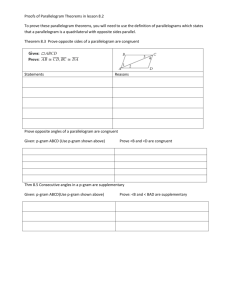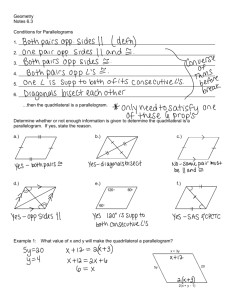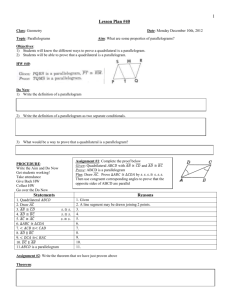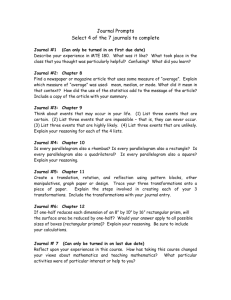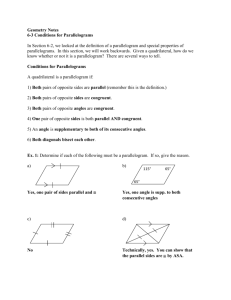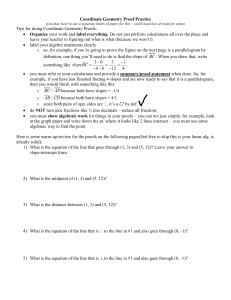Chapter 6 Test Review Deductive Geometry COmpatible
advertisement
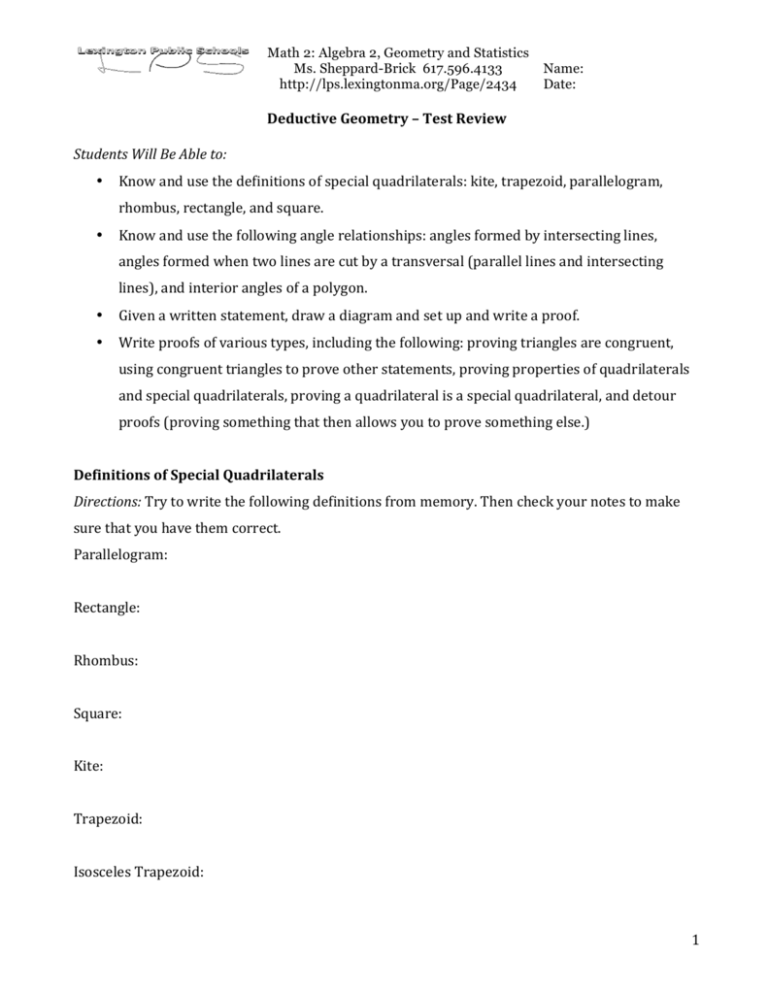
Math 2: Algebra 2, Geometry and Statistics Ms. Sheppard-Brick 617.596.4133 http://lps.lexingtonma.org/Page/2434 Students Will Be Able to: • Name: Date: Deductive Geometry – Test Review Know and use the definitions of special quadrilaterals: kite, trapezoid, parallelogram, rhombus, rectangle, and square. • Know and use the following angle relationships: angles formed by intersecting lines, angles formed when two lines are cut by a transversal (parallel lines and intersecting lines), and interior angles of a polygon. • Given a written statement, draw a diagram and set up and write a proof. • Write proofs of various types, including the following: proving triangles are congruent, using congruent triangles to prove other statements, proving properties of quadrilaterals and special quadrilaterals, proving a quadrilateral is a special quadrilateral, and detour proofs (proving something that then allows you to prove something else.) Definitions of Special Quadrilaterals Directions: Try to write the following definitions from memory. Then check your notes to make sure that you have them correct. Parallelogram: Rectangle: Rhombus: Square: Kite: Trapezoid: Isosceles Trapezoid: 1 Math 2: Algebra 2, Geometry and Statistics Ms. Sheppard-Brick 617.596.4133 http://lps.lexingtonma.org/Page/2434 Name: Date: Note: use separate paper when appropriate. Part 1. Proofs: Complete the following proofs. 1. Given: parallelogram ABCD with diagonals intersecting at point O. Prove: XO = YO C 2. Given: D is the midpoint of AC , E is the midpoint of DF , and 3 CE ≅ EB 1 D E Prove: ADFB is a parallelogram. F 2 4 A B E 3. Given: ABCD is an isosceles trapezoid with bases AB and DC. D C Prove: ABE and CDE are isosceles triangles. A B C 4. Given: ABCD is a rhombus with ∠B a right angle D Prove: ABCD is a square. B A 5. 2 Math 2: Algebra 2, Geometry and Statistics Ms. Sheppard-Brick 617.596.4133 http://lps.lexingtonma.org/Page/2434 Name: Date: Part 2. Set Up But Do Not Prove: Create a diagram and a “Given” and a “Prove” statement. Do not write a proof. 6. In a parallelogram, the distances to a diagonal from two opposite vertices are equal. 7. In a parallelogram, a line segment drawn through the midpoint of a diagonal and ending in a pair of opposite sides is bisected by the diagonal. 8. A parallelogram is a rectangle if it has one right angle. 9. If the diagonals of a quadrilateral bisect each other, the quadrilateral is a parallelogram. 10. In triangle RST, RS = RT. Prove that the bisector of an exterior angle at S is parallel to RT. 11. The measure of an exterior angle of a triangle is equal to the sum of the two non-­‐adjacent interior angles. 12. Both pairs of opposite sides of a parallelogram are congruent. 13. The corresponding altitudes of two congruent triangles are congruent. Part 3. Algebra Problems: (include using algebra to show that a quadrilateral is special) 14. Find the measure of angle ABE 16. Find the value of x. 15. Find the value of x. 17. Find the measures of angle QRP in terms of x. 18. 3 Math 2: Algebra 2, Geometry and Statistics Ms. Sheppard-Brick 617.596.4133 http://lps.lexingtonma.org/Page/2434 Name: Date: 19. In parallelogram ABCD, angle B has a measure of 3x – 12 and angle D has a measure of x + 40. Find the measure of each angle in the parallelogram. 20. In parallelogram ABCD, AB = 4x + y, BC = y + 4, CD = 3x + 6 and DA = 2x + y. Find the measure of each side length. 21. If AB = DC, determine whether ABCD is a rhombus. 2x + 5 A 22. FGHJ is a parallelogram. Is it a rectangle? G (8x-2)° B H (6x-2)° 3x - 2 27 D 4x - 17 C (124.5 - 3x)° F J 23. KLMJ is a kite with KL = KJ. Find the measure of angle K. 24. NOPQRS is equiangular. Find x and y. O P L (15x)° K (12x + 31)° N Q (9x - 13)° 115° J M (5y + 80)° S R Part 4. Prove or Disprove. Determine whether each statement is true or false. If the statement is true, write a formal proof. If the statement is false, explain or give a counterexample. 25. An equiangular parallelogram is a square. 26. If two angles are congruent and supplementary, then they are right angles. 27. If two opposite sides of a quadrilateral are both congruent and parallel, then the quadrilateral is a parallelogram. 28. The diagonals of a rhombus are congruent. 29. The diagonals of a square bisect the angles of a square. 30. If a triangle is a right triangle, then the acute angles are complementary. 4
